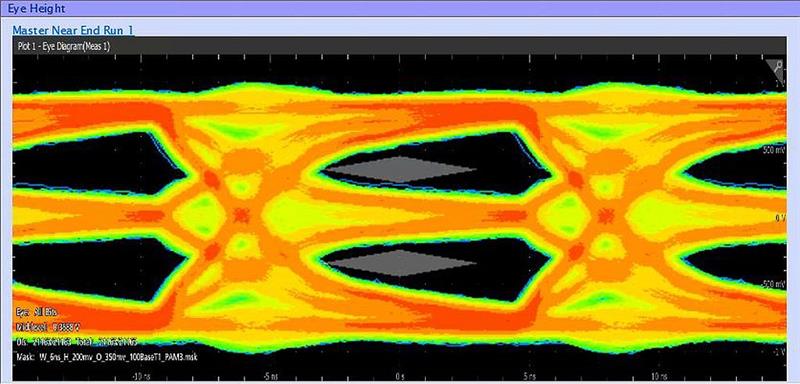Today, many automotive development efforts employ a multitude of systems from different sources, requiring developers to spend considerable time and effort trying to tie them all together.
To bring these systems together, the industry is rapidly moving toward adoption of Automotive Ethernet standards including OPEN Alliance, Autosar, IEEE or Avnu for in-vehicle networking. But this move doesn’t come without its own set of challenges. In particular, the integration of Automotive Ethernet technology will require rigorous design validation and testing to ensure interoperability between multiple ECUs and to ensure that the network and devices will perform reliably under real world conditions.
Full-duplex communications, PAM3 signaling add complexity
Automotive Ethernet physical layer operates as a full-duplex communication link over a twisted pair cable with PAM3 signalling as shown below. This PHY link can become error prone at high temperatures and can degrade due to any number of factors such as cabling and connectors or electrical and magnet noise.

An oscilloscope-generated eye diagram is the best overall indicator of PHY health and produces two eyes as shown in Figure 2 because of the three amplitudes in PAM3 signalling. Scopes are also
 Figure 2. The three amplitudes in PAM3 generates two eye diagrams. This type of testing is critical to validating Automotive Ethernet performance under real-world conditions.
Figure 2. The three amplitudes in PAM3 generates two eye diagrams. This type of testing is critical to validating Automotive Ethernet performance under real-world conditions.
useful for performing protocol decode timing measurements. As the industry moves to a domain controller architecture, gateways will be needed to convert existing CAN-based systems to Automotive Ethernet and vice versa. Accurate timing measurements at the system level are critical in such cases to measure latency.
Avoiding directional couplers
Unfortunately, many of the current testing solutions require breaking the Automotive Ethernet cable to perform tests. To perform signal analysis or protocol decode in the real system environment, the traffic of the master and the slave ECU need to be separated. Typically this involves cutting the cables to install a directional coupler, adding insertion and return loss that can negatively impact testing results and deteriorate signal to noise ratio. Moreover, directional couplers are difficult to use.
To address this challenge, the industry is moving toward the use of tools that use advanced software to actually separate full-duplex traffic to facilitate testing under real-world conditions without the use of directional couplers. Tests can include different cable lengths and types, different ECUs, ECU-to-switch conditions, ECU and protocol analyzer, different noise conditions, and inside the car with Automotive Ethernet connectivity.
System-level testing to address complexity
With capable Automotive Ethernet PHY test solutions coming together, focus is also turning toward addressing test complexity and creating better end-to-end test solutions. Such solutions will combine multi-layer compliance test, multi-protocol real time analysis and in-depth debug, all controlled through a single user interface. With a system-focused approach, comprehensive in-vehicle networking test solutions will bridge the development cycle from the initial design phase through production to maintenance and repair and open the door to the more advanced, more reliable and safer vehicles of the future.
Author details: Dean Miles is Head of EMEA Technical Marketing Managers at Tektronix













